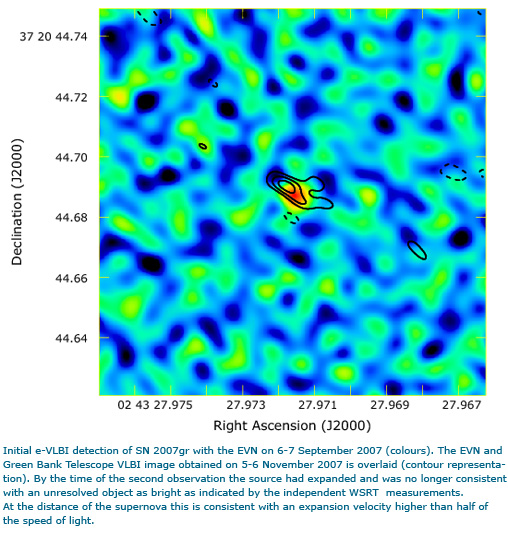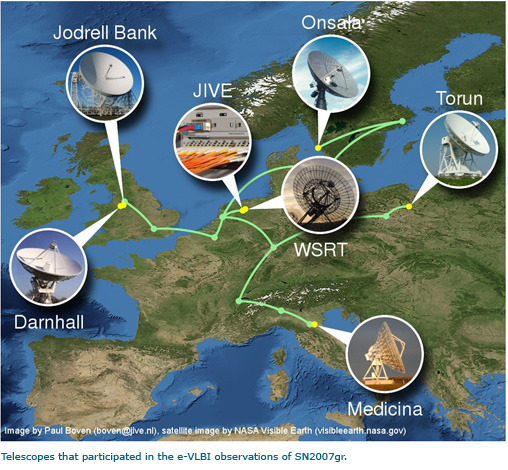GÉANT Network enables international team to observe major supernova explosion
25 February 2010 | Cambridge, UKAn international team of scientists have been able to make detailed observations of a supernova thanks to the high capacity pan-European GÉANT research network and the European National Research and Education Networks (NRENs) that GÉANT interconnects. Astronomers at six telescopes throughout Europe collaborated to observe Supernova SN 2007gr, detecting outflow near the speed of light for the first time ever from this type of star and gaining vital insight into supernova behaviour.
Through a technique called real-time, electronic Very Long Baseline Interferometry (e-VLBI), astronomers at telescopes in the UK (Jodrell Bank and Darnhall), Italy (Medicina), Poland (Torun), Sweden (Onsala) and the Netherlands (Westerbork) simultaneously observed the supernova. Data collected by each telescope was sampled and sent to a central processor at the Joint Institute for VLBI in Europe (JIVE) in the Netherlands via GÉANT (operated by research networking organisation DANTE ) and the NREN networks. This central data processor, a purpose-built supercomputer, decodes, aligns and correlates the data for all possible pairs of telescopes. This results in the generation of images of cosmic radio sources with up to 100 times better resolution than images from the best optical telescopes.

The findings of the observation, published in the Nature journal, reported the detection for the first time ever of a relativistic outflow in a Type Ic supernova, thus supporting the link with the even more energetic Gamma Ray Bursts, some of the most energetic explosions in the Universe.
A supernova forms when the central region of a massive star collapses at the end of its life, while its outer layer is expelled in a gigantic explosion. Supernova SN 2007gr was discovered in 2007 using the Katzman Automatic Imaging Telescope in California, USA and optical observations showed that it was Type Ic, known to result from the most massive stars.
As supernovae are very distant sources, and the radio emissions they produce fade quickly, the highest resolution imaging techniques such as e-VLBI are required to receive the extremely faint emissions and reveal the details of the explosion process. As SN 2007gr was located in a relatively nearby galaxy, closer than any other Type Ic supernovae detected in the radio spectrum, it offered a unique opportunity to study this phenomenon.
Rapid analysis of the SN 2007gr data, sent across the GÉANT network, showed that the source was still visible in the radio spectrum, and confirmed the technical feasibility of radio observations. Based on this result, the team carried out further observations with the European VBLI Network and the Green Bank Telescope in West Virginia, USA.

“Astronomy research into phenomena such as supernovae give unrivalled insight into the universe and how it operates,” commented Dai Davies, general manager, DANTE. “This latest research project demonstrates how international collaboration delivers results that dramatically increase our knowledge of the universe. Without high speed connectivity such real-time observations would be impossible, showing the power of research networking to assist leading organisations such as JIVE in their endeavours.”
“Organising VLBI observations on a short timescale with the most sensitive radio telescopes on Earth is a challenging task,” notes JIVE director Huib Jan van Langevelde. “Using the electronic-VLBI technique eliminates some of the major issues. Moreover it allows us to produce immediate results necessary for the planning of additional measurements. The scientific outcome from the SN 2007gr observations shows the impact of the technological development in our field in the last few years, which allows highly efficient collaboration between radio telescopes within and even outside of Europe.”
About DANTE
DANTE is a non-profit organisation, coordinator of large-scale projects co-funded by the European Commission, and working in partnership with European National Research and Education Networks (NRENs) to plan, build and operate advanced networks for research and education. Established in 1993, DANTE has been fundamental to the success of pan-European research and education networking. DANTE has built and operates GÉANT, which provides the data communications infrastructure essential to the success of many research projects in Europe. DANTE is involved in worldwide initiatives to interconnect countries in the other regions to one another and to GÉANT. DANTE currently manages projects focussed on the Mediterranean, Asia-Pacific and central Asia regions through the EUMEDCONNECT, TEIN and CAREN projects respectively. For more information, visit www.dante.net
About JIVE
The Joint Institute for VLBI in Europe (JIVE, www.jive.nl) is a scientific foundation with a mandate to support the operations of the European VLBI Network (EVN). For this purpose it maintains, operates and develops the MKIV EVN Data Processor, a powerful supercomputer that combines the signals from radio telescopes located across the planet. Through this technique, called Very Long Baseline Interferometry (VLBI), astronomers can make detailed images of cosmic radio sources, providing astronomers with the clearest, highest resolution view of some of the most distant and energetic objects in the Universe.
Contact:
Paul Maurice
DANTE
+44 (0)1223 371 300
paul.maurice@dante.org.uk
Chris Measures/Matt Watson
Speed Communications (on behalf of DANTE)
+44(0)20 7842 3200
dante@speedcommunications.com

